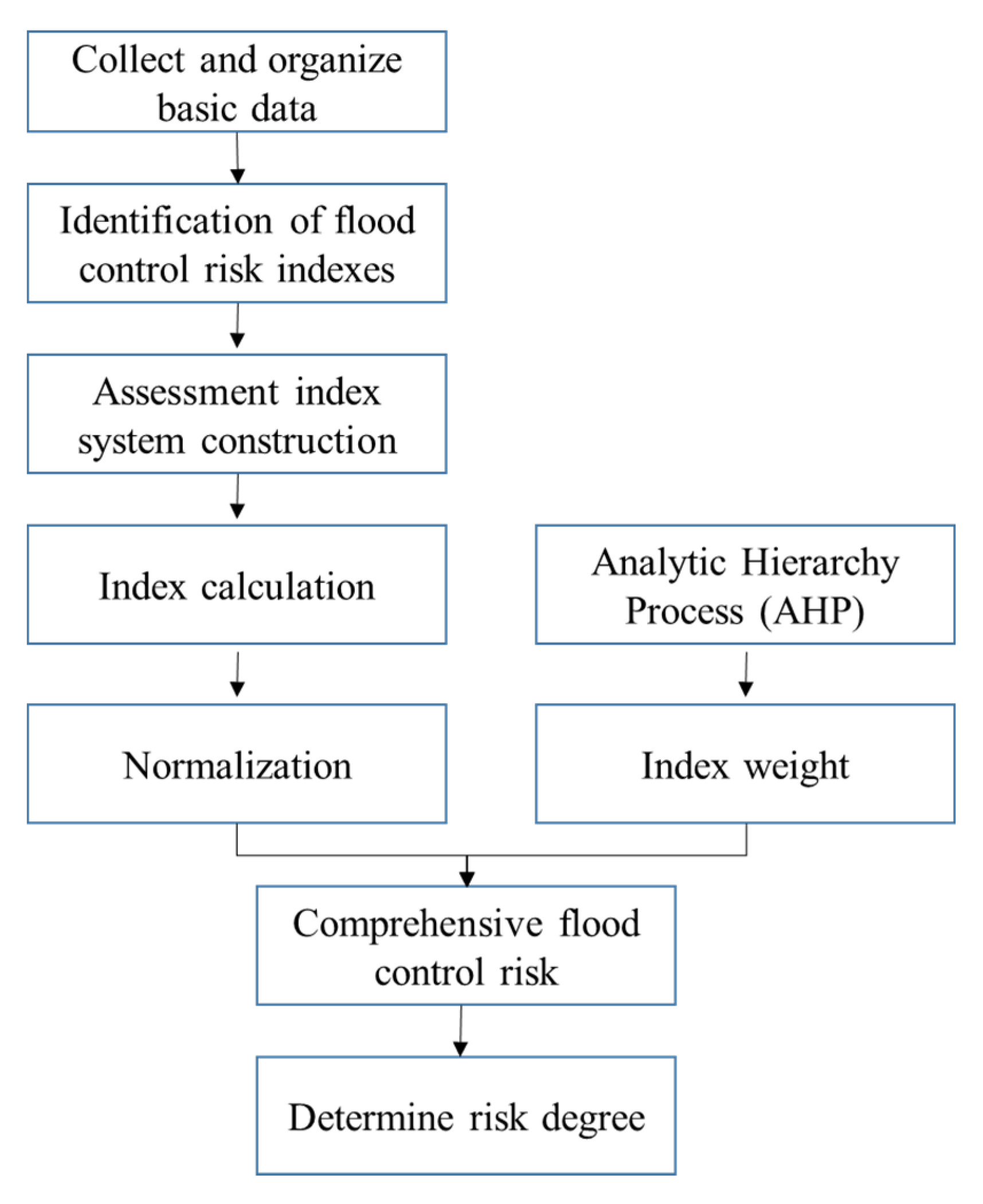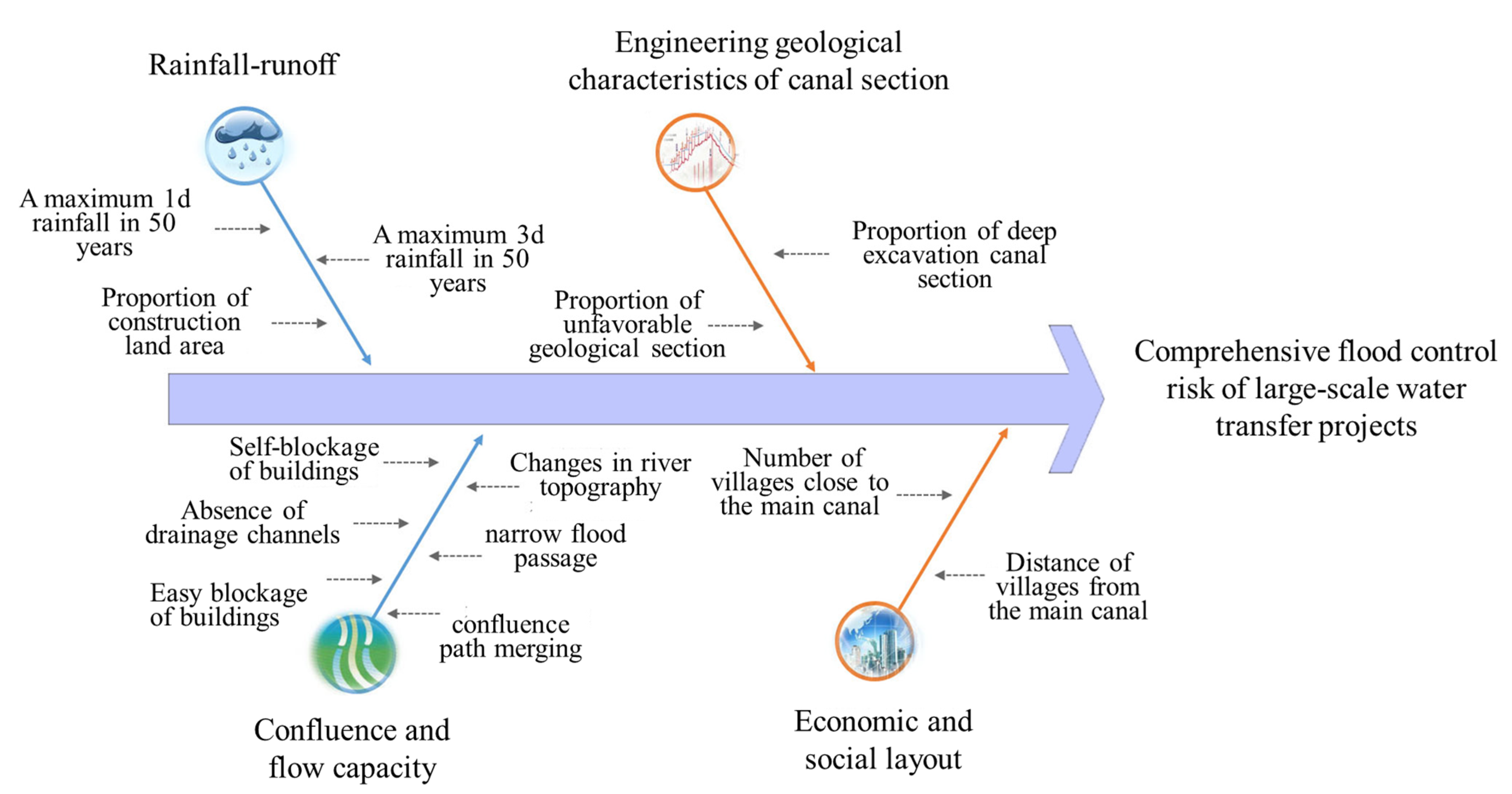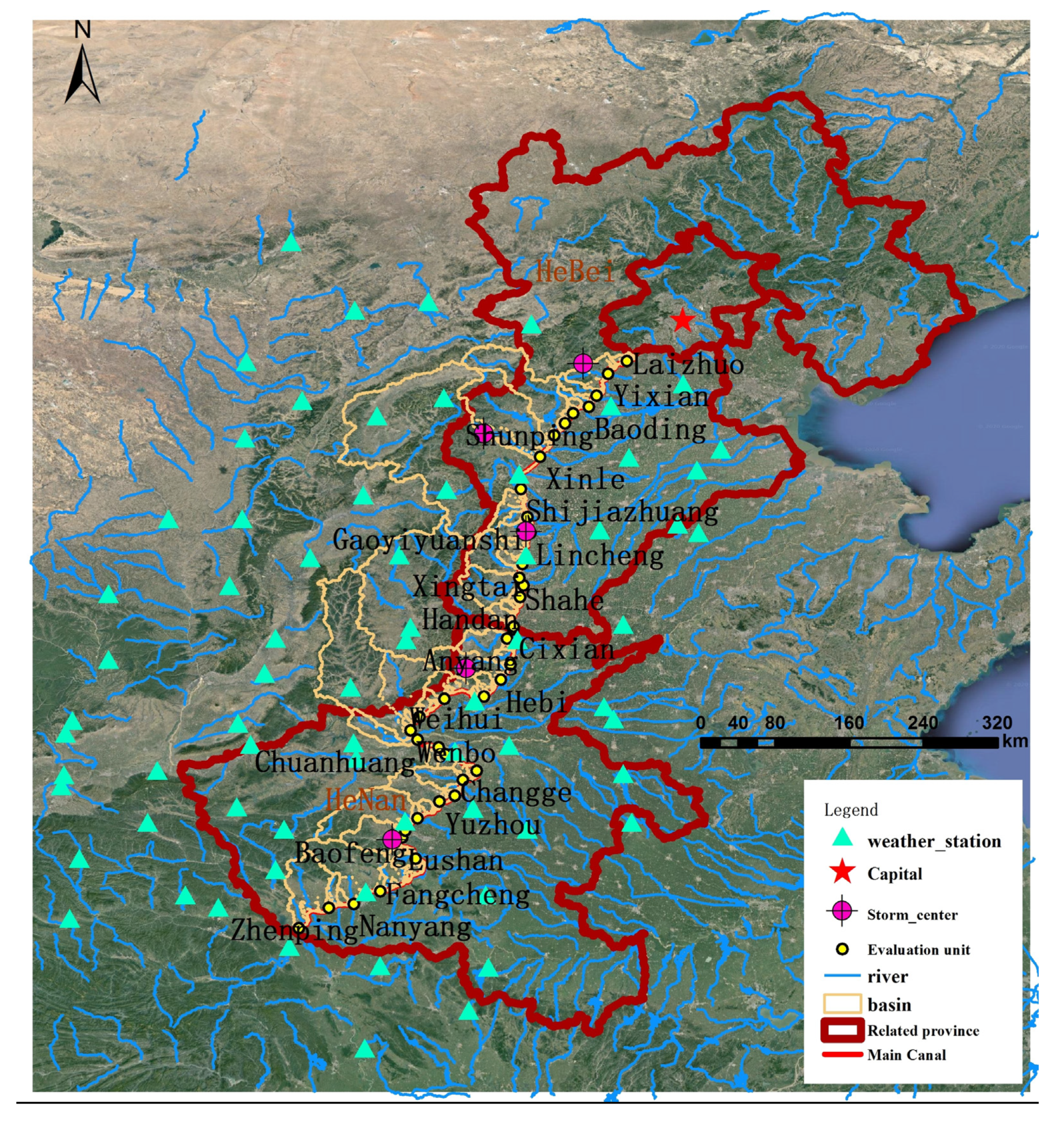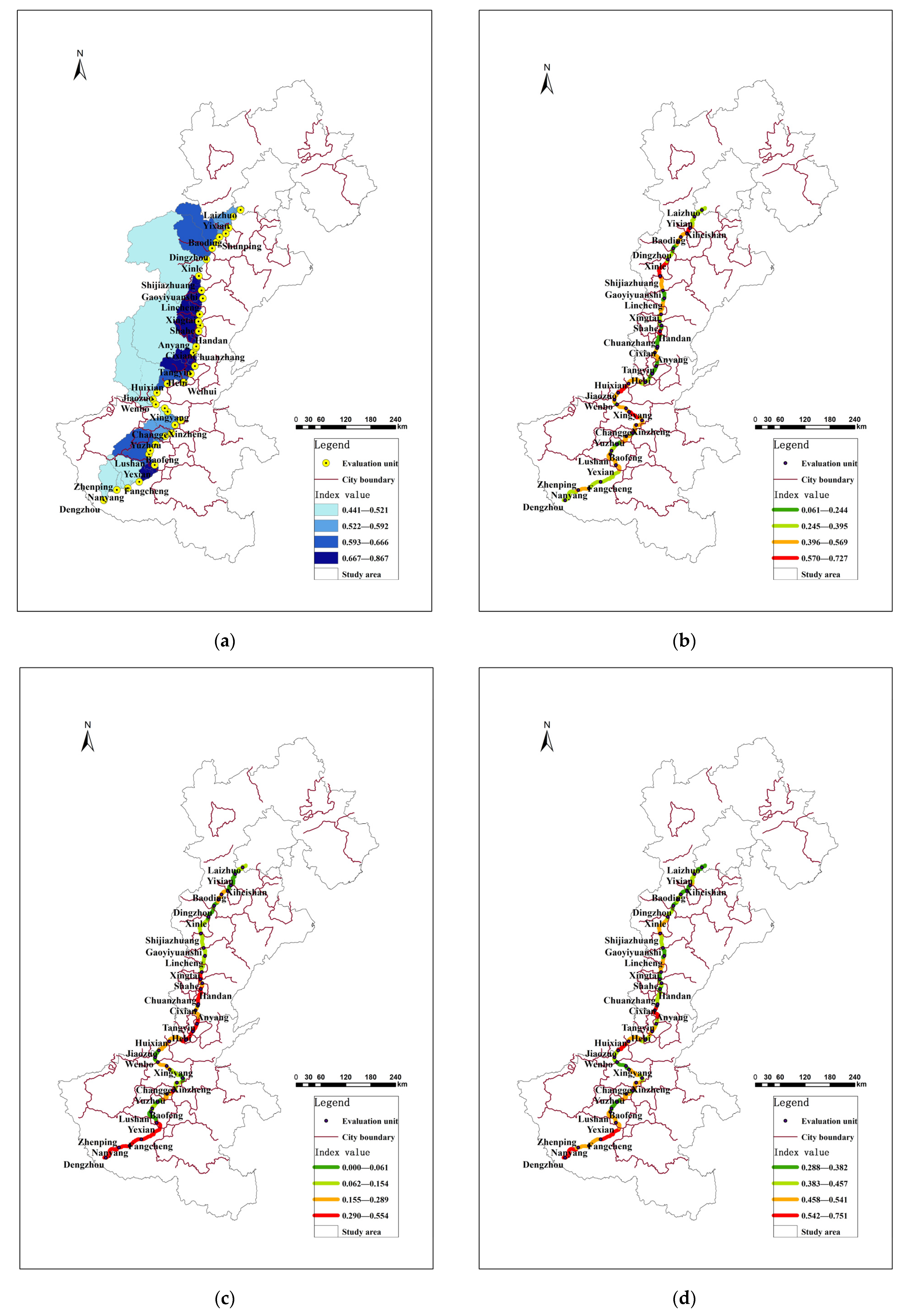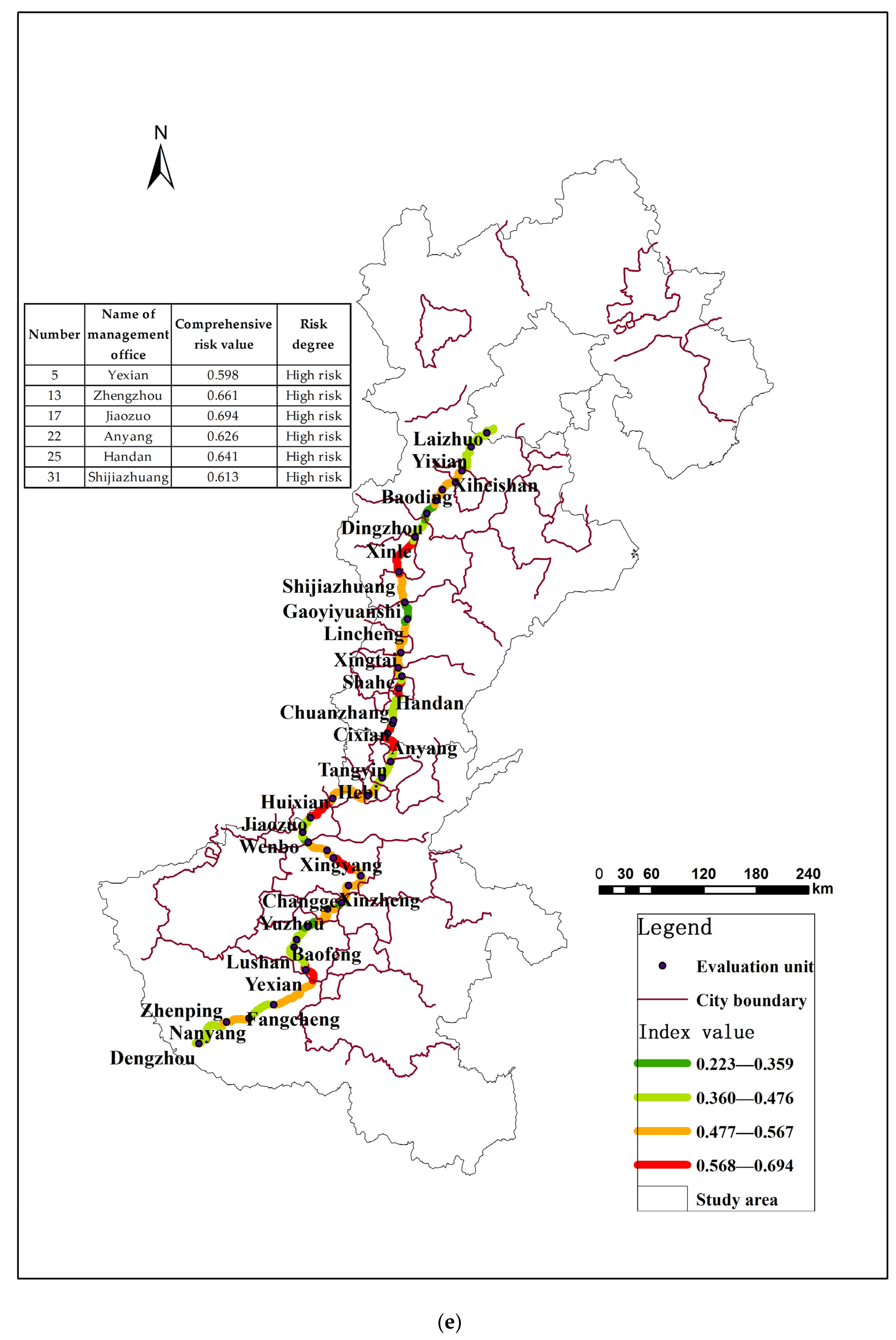1. Introduction
Due to the limitations of natural endowment conditions and the rapidly increasing demand for water [
1], water shortage has become a key factor restricting social and economic development in many countries and regions [
2,
3,
4,
5]. The construction of a large-scale inter-basin water transfer project is an important measure to solve the uneven spatial and temporal distribution of water resources in time and space, and to support the sustainable economic and social development of water-affected receiving regions [
6,
7,
8,
9]. The so-called ‘water transfer project’ means ‘to divert, regulate, and supply water from water rich areas to water deficient areas’, to realize the optimal allocation of water resources. The water transfer project is a large-scale series system with long engineering routes [
10], often crossing different basins and river systems, passing through different climate zones and water receiving areas [
11,
12]. The project climate and underlying surface conditions are complex and diverse, and there are many uncertainties and risk factors, among which flood control risk is one of the main risks affecting the safe operation of the large-scale water transfer project [
13,
14].
At present, there are more qualitative descriptions and fewer quantitative assessments of flood control risk analysis of large-scale water transfer projects. For the identification of risk factors—flood risk, earthquake, freezing and other natural disasters, are generally regarded as a class of factors that affect the safe operation of the project [
15]. Hydrologic risk factors are given more attention, but the flood risk of the project is not (systematically and comprehensively) identified in combination with the structural characteristics of different cross-sectional buildings and the engineering geological characteristics of the canal section. Tian Ying et al. [
16] identified the risk factors of floods, earthquakes, and other geological disasters, which may lead to dam collapse, as engineering risk factors of cross-border river safety. In terms of quantitative assessment, the comprehensive flood control risk of a certain channel section is analyzed from the perspective of the possibility of water damage in the cross-sectional buildings [
17,
18]. For example, whether the designed rainstorm (flood) in the basin above the cross-sectional area (exceeding the design standard of the cross-sectional building) is taken as the measurement standard, or the probabilistic inference network method is used to evaluate the flood risk degree of each channel by integrating the flood level and anti-risk ability level. Song Qian et al. [
18] identified some risk factors—flood damage, earthquake damage, freezing disaster, inadequate design, construction, and operation maintenance, based on the failure modes of cross buildings. Zhu Yuan et al. [
19] adopted the method of combination, established the flood risk calculation framework of the main canal, and proposed a two-dimensional composite event risk calculation model. Liu Heng et al. [
20] proposed a failure risk calculation model, which is suitable for cross-sectional buildings under various flood conditions. The basic premise of the probabilistic combination method [
21] is as follows: it is assumed that the cross-sectional buildings will be destroyed, and the water supply of the main canal will be interrupted when the cross-sectional buildings is subjected to a flood exceeding the standard design. However, in the actual situation, this is not necessarily the case, and the method is relatively complicated and not convenient for general technical and engineering management personnel.
From the perspective of hydrological factors, torrential rain is the source of risk for catastrophic floods, and the rise in the river water level is a risk event caused by torrential rain; considering the safety of the water transfer project, the rise in the upstream water level of the crossing building is the risk source of engineering diseases, and flood damage to the project is a risk event. In turn, this may adversely affect local flood control on the left and right banks of the main canal. Therefore, in view of super-large and complex engineering systems, such as water transfer projects, based on the systematic identification of various risk sources, risk events, their causes, and the potential consequences, and based on the risk assessment theory, flood risk assessment of the whole disaster chain process should be carried out by integrating risk factors, such as the risk of flood disaster factors, the exposure of the disaster-bearing body and the vulnerability of the disaster pregnant environment.
In view of the deficiencies of the existing flood control risk assessment method, this paper proposes a flood control risk identification and assessment method for large-scale water transfer projects. From the perspective of the whole rainfall–runoff chain, flood process, and flood impact, combined with the characteristics of the different water conveyance canal sections, and the structural characteristics and flow capacity of the cross-sectional buildings, the authors comprehensively and systematically analyzed the flood control risk of upstream flood factors regarding the safety and local impact of the canal section, and constructed a flood control risk rating index system for the water transfer project. At the same time, a comprehensive quantitative assessment method is proposed to determine the flood risk level of the canal section, which could provide scientific support for decision-making on flood risk management for the water transfer project.
2. Flood Control Risk Identification and Assessment Methods
The overall idea and technical process of flood control risk identification and an assessment of a large-scale water transfer project are shown in
Figure 1. Based on the systematic and comprehensive identification of flood control risk factors, the risk factors are refined and decomposed, the flood risk indexes are reasonably determined, the assessment index system and calculation method are constructed, the risk indexes are normalized, the weight of each index is calculated using AHP, the comprehensive flood control risk assessment model is established, and the comprehensive flood control risk and its grade are determined.
2.1. Flood Control Risk Identification of Large-Scale Water Transfer Project
A large-scale water transfer project has the characteristics of long lines, variable climate, geography, hydrology, and underlying surface conditions, and complex structures of cross-sectional buildings. Starting with all kinds of risk sources and risk events involved in the whole process of the flood disaster chain, combined with risk theory, flood control risk factors of the large-scale water transfer project include some aspects: rainfall–runoff, confluence, and flow capacity, the geological characteristics of canal section, and economic and social layout. Among them, the risk of rainfall–runoff includes the rainfall intensity, rainfall, and flood volume in the upstream catchment area of the crossing building, which reflects the risk of flood disaster factors. The risk of confluence and flow capacity are reflected in confluence path merging, concentrated outflow, blocked drainage channels, the narrow flood section of upstream and downstream rivers of buildings, significant changes in river topography, siltation of buildings, or risks of easy blockage. Those factors will lead to changes in flood process, such as high water levels, increase in flow velocity, and erosion to the source, which will aggravate the flood risk and increase the uncertainty risk of crossing building structures. The risk factors of the engineering geological characteristics of the canal section reflect the exposure of the disaster-bearing body, including adverse geological sections (expansive soil, high groundwater level, etc.) and deep excavated canal sections. The corresponding risk events are the risk of water destruction, external flood intrusion, and slope instability, respectively. The economic and social layout risks account for the adverse impacts of floods on the local economy and society in the project area, such as the distribution of towns and villages within a certain range of the project area, which reflects the vulnerability of the disaster environment.
2.2. Assessment Index System of Flood Control Risk
Based on the systematic identification of flood control risk factors of a large-scale water transfer project, considering the availability of data and relative independence of indicators, four types of risks are refined and decomposed, the assessment indicators are reasonably determined, and a flood control assessment index system for a water transfer project with a certain hierarchical structure is constructed.
Specifically, the rainfall–runoff risk assessment index selects three indicators: a maximum 1-day rainfall in 50 years, a maximum 3 days rainfall in 50 years, and the proportion of construction land area. Among them, the maximum 1 d rainfall reflects the rainfall intensity and corresponds to the peak flow; the maximum 3 d rainfall focuses on the total rainfall and corresponds to the magnitude of the flood. The selection of 1 d, 3 d, and 50 years design frequencies are mainly based on the practical experience of the built, large-scale water transfer project, determined by taking the upstream confluence area of the project, the characteristics of the rainstorm flood, and other factors into account. The proportion of construction land area represents the impervious surface of the upstream catchment area. The more impervious area is not conducive to the infiltration of rainfall, and is easier for rapid flow generation, leading to an increase in flow generation, increase in flood volume, and advance in flood peak, etc.
There are six indicators for the risk assessment index of the confluence and flow capacity, which are a narrow flood passage, changes in river topography, confluence path merging, presence (or absence) of drainage channels, self-blockage of buildings, and the risk of easy blockage of buildings. According to the relative position and the elevation of the canal (river) bottom of the main canal and the crossing river, this can be divided into two types of crossing building: the canal crossing river buildings; that is, the main canal crossing the natural river by building an artificial water conveyance channel (structural type: beam aqueduct, culvert aqueduct, channel inverted siphon and culvert); or the river crossing canal building; that is, artificial flood drainage channels built to allow natural water to pass through (or across) the main canal (structural types: flood discharge aqueduct, river inverted siphon, and flood discharge culvert), as shown in
Figure 2. According to the catchment area thresholds above the cross-sectional buildings, they could be divided into large cross-sectional buildings and left bank drainage buildings. Differences in the river size and the cross-sectional buildings structure type lead to different risk factors and assessment indexes. Among them, two indexes—narrow flood passages and river topography change—are for larger rivers, and the other four indexes are for rivers with a smaller catchment area, upstream of the project.
The risks of geological characteristics at the canal section are characterized by an unfavorable geological section and a deep excavation canal section. The risk of an economic–social layout is represented by the distance of villages (towns) from the main canal and the number of villages (towns) close to the main canal. Referring to the relevant experience of a project and the trial calculation results of substandard flooding, the villages, and towns within 1 km upstream and 3 km downstream of the main canal are mainly considered. The overall flood control risk identification and index decomposition of large-scale water transfer project are shown in
Figure 3.
2.3. Index Calculation and Normalization
2.3.1. Basic Index Calculation
In the risk assessment index of rainfall–runoff, the calculation of the maximum 1-day rainfall in 50 years and the maximum 3-day rainfall in 50 years is, first, based on the long sequence of daily rainfall data of meteorological stations in the project area. The annual maximum 1- and 3-d rainfall series data are obtained and arranged in descending order, then the frequency analysis method is used to calculate the maximum 1- and 3-d rainfall in 50 years for each station. According to China’s criterion, ‘Regulation for calculating design flood of water resources and hydropower projects’, the frequency analysis steps are as follows: first, the expected formula is adopted to calculate the empirical frequency. Second, a linear moment method is used to calculate the initial parameters. Third, the Pearson III hydrological frequency distribution line is selected for parameter estimation. Fourth, the computer-optimized line fitting method is used to determine the parameters. Furthermore, using the Kriging interpolation method, the point data of each station are interpolated and distributed to the spatial surface, to obtain the grid data of regional rainfall, and finally the maximum 1- and 3-d rainfalls in 50 years in the upstream catchment area of the channel section can be evaluated. The proportion of construction land area is obtained by evaluating the ratio of construction land area and total catchment area in the upstream catchment area of the canal section.
Among the risk assessment index of confluence and flow capacity, the index value of narrow flood discharge sections is obtained by the ratio of the number of rivers with a narrow flood passage compared to the total number of larger rivers in the assessment channel section. The index value of river topography changes is obtained by the ratio of the number of rivers with sand mining pits (1 km upstream and 3 km downstream of the crossing section) to the total number of rivers in the assessment channel. The index value of confluence path merging is obtained by the ratio of the current number of rivers in the assessment channel to the total number of rivers before the project construction, the latter of which can be obtained based on the actual investigation, or extracted by the project areal DEM. The index value of the presence (or absence) of drainage channels is represented by the proportion of the number of projects with no drainage channels or unsmooth drainage in the left bank drainage project. The index value of the self-blockage of buildings, and the risk of easy blockage of buildings, are obtained by the ratio of the number of left bank buildings with self-blockage or easy blockage (drainage-inverted siphon, drainage aqueduct, etc.) to the total number of left bank drainage buildings.
The two indexes, the unfavorable geological section proportion and the deep excavation canal section proportion, which are related to the risk of the engineering geological characteristics of the canal section, are, respectively, calculated by the length of the bad geological section (e.g., the section of expansive soil and high groundwater level), and the length of the deep excavation section (generally more than 20 m [
22]) compared to the total length of the assessment section. For the risk index of the economic and social layout, the sum of the number of villages and towns on both sides, within the range of 1 km upstream to 3 km downstream the canal section, is taken as the index value of the number of villages (towns) close to the main canal. Taking the range of 1 km upstream and 3 km downstream as the boundary, the average distance (km) between villages (towns) and the main canal is calculated, divided by 1 km and 3 km, respectively, and the smaller value is taken as the index of the distance between the villages (towns) and the main canal.
2.3.2. Unification of Basic Index Attributes
Each basic flood control risk index attribute can be divided into a positive index and negative index. For the positive index, the higher the index value, the greater the flood risk degree. For the negative index, the higher the index, the lower the flood risk degree. In flood risk assessment indexes—different measurement indexes have different attributes, and cannot be added directly. It is necessary to convert the negative index into the positive index, so that all the indexes have the same risk effect [
23].
Most of the indicators listed in
Table 1 are positive indexes, among which the “Confluence path merge” and “Distance between villages (towns) from the main canal” are negative indexes.
2.3.3. Dimensionless of Basic Indexes
Some basic flood risk indexes have different dimensions and magnitudes, which cannot be directly integrated, and the original indexes need to be dimensionless [
24]. Most of the indexes listed in
Table 1 are in the range of 0–1, such as the proportion of construction land area, the risk assessment index of confluence and flow capacity, and the risk of the engineering geological characteristics of the canal section, while the maximum 1- and 3-d rainfall in 50 years, and the number of villages (towns) close to the main canal are specific values, which need to be normalized.
At present, commonly used dimensionless methods mainly include extremum, standardization, normalization, and standard deviation. Among them, the extremum method can minimize the order of magnitude difference between the indexes and keep the coefficient of variation unchanged [
25]. In this paper, the maximum method of the extremum is adopted in the dimensionless of basic indexes. The formula is as follows:
where
represents the original data, and
represents the dimensionless result of
.
2.4. Determination of Index Weight
The analytic hierarchy process (AHP) is a decision-making method that combines qualitative analysis and quantitative calculation, proposed by the American operations researcher, Professor T. L. Saaty, in the 1970s [
26]. By integrating the decision-making thinking of the decision-makers (regarding complex objects), the decision-maker’s thinking process (again, regarding complex objects) is made hierarchical and quantitative, and a series of mathematical operations are carried out to obtain different weights, providing a basis for the selection of the best plan [
27,
28]. The AHP steps are as follows: (i) the hierarchical structure model is established; (ii) the judgment matrix is constructed; (iii) the maximum eigenvalue of the judgment matrix and its corresponding eigenvector are calculated; (iv) the consistency of the judgment matrix is checked; (v) finally, the hierarchy is sorted [
29,
30].
2.5. Comprehensive Flood Risk Assessment Model
According to the concept of risk and the calculation formula of flood risk indexes, the following comprehensive flood risk assessment model is established.
where FR is the index of comprehensive flood control risk, and R, F, C, S are the flood control risk index of four first-class risk indexes, namely, rainfall–runoff, confluence and flow capacity, engineering geological characteristics of the canal section, and economic and social layout risk.
,
,
,
are the index values of secondary flood control risk indexes under four primary flood control risk indexes.
,
,
,
are the weight values of rainfall–runoff, confluence and flow capacity, the engineering geological characteristics of the canal section, and economic and social layout risk,
,
,
,
are the secondary weight values, after the four primary flood control risk index weights.
2.6. Determination of Comprehensive Flood Control Risk Level of Canal Section
According to the established comprehensive flood control risk assessment model, the flood risk quantification index (FR) of the evaluation channel section is calculated. The greater the risk index value, the higher the risk degree. The Natural Breaks (Jenks) tool in the ArcGIS 10.1 platform is used to grade the flood comprehensive risk index; this method uses the minimum variance sum to determine the optimal classification result. Compared with other classification methods, the goodness of variance fit [
31] is the highest, which objectively reflects the statistical characteristics of data distribution. In this study, the comprehensive flood control risk level of the water transfer project is divided into four levels: no risk, low risk, medium risk, and high risk.
4. Results Analysis and Discussion
4.1. Spatial Distribution of Flood Control Risks
According to the assessment results of the middle route of the South-to-North Water Transfer Project, the four single index risk spatial distribution maps of rainfall–runoff, confluence and flow capacity, the geological characteristics of canal section, the economic and social layout, as well as the comprehensive flood control risk spatial distribution map, were drawn, as shown in
Figure 5.
Regarding the risk of rainfall–runoff, Tangyin, Shahe, Anyang, Yongnian, Cixian, Hebi, Handan, and Gaoyi Yuanshi have a higher risk level, which is consistent with the distribution of rainstorm centers in Jizhong in the upper reaches of Shahe River, Hebi in the upper reaches of Qihe River, and ZhangMo in the upper reaches of the Dihe River. Regarding risk of confluence and flow capacity, Zhengzhou, Jiaozuo, Shijiazhuang, Handan, Baoding, Hangkonggang, Yexian, and Anyang have a higher risk level, which is consistent with the situation obtained in the investigation of assessment units (canal section). For example, in the Zhengzhou assessment unit, there are 16 cross-sectional buildings, including seven large-scale river cross-sectional buildings and nine left bank drainage buildings. Among them, four large-scale river cross-sectional buildings have a narrow flood section, and all left bank drainage buildings have poor drainage. In the Jiaozuo assessment unit, five of the eight large-scale river channel cross-sectional buildings have narrow flood section, and all three left bank drainage buildings have poor drainage and easy blockage risk. In the Shijiazhuang assessment unit, there are six large-scale river cross-sectional buildings, of which three have narrow flood section, 9 of 11 left bank drainage buildings have poor drainage, and most of them have the risk of self-blockage or easy blockage. Regarding the engineering geological characteristic risks of the canal section, the risk levels of the canal sections in Dengzhou, Shahe, Handan, and Hebi are higher, consistent with the assessment unit’s (canal section) investigation and statistics. For example, the canal length in the Dengzhou evaluation unit is 5.18 km, the length of the unfavorable geological section (expansive soil, high groundwater level) is 3.46 km, and the length of the deep excavation canal section is 2.28 km. Among the economic and social layout risks, Fangcheng, Anyang, Jiaozuo, Dengzhou, Huixian, and other canal sections have higher risk levels, because the main canal runs through urban sections or concentrated villages in these areas, and the degree of economic and social development along the lines is relatively high.
4.2. Analysis of High-Risk Units
According to the comprehensive assessment results, Yexian assessment unit (0.5983), Shijiazhuang assessment unit (0.6133), Anyang assessment unit (0.6260), Handan assessment unit (0.6414), Zhengzhou assessment unit (0.6610), and Jiaozuo assessment unit (0.6938) are high-risk areas for flood control. The top five risk factors of those assessments with a high degree of risk are listed in
Table 6.
4.3. Suggestions on Flood Control Measures
According to the flood control risk level of the main canal (Beijing section) in the first phase of the middle route of the South-to-North Water Transfer Project, different risk countermeasures could be adopted.
No risk means no consideration. For low risk, which is an acceptable risk, the countermeasures are attention, maintaining normal monitoring frequency, and daily inspections. For medium risk, which is a tolerable risk, the countermeasures are monitoring, strengthened monitoring, and daily inspections, as well as measures to control the risk when necessary, which should be sorted according to importance to ensure that the main risk indexes can be dealt with. High risk belongs to unacceptable risks. The countermeasures refer to taking measures to prevent, eliminate, evade, or reduce the occurrence of risk accidents, according to the main risk factors, to reduce the risk level to tolerable or acceptable levels. At the same time, emergency plans should be prepared and, in case of danger, emergency measures (e.g., repair and remedy) should be carried out.
Risk countermeasures are carried out using two aspects: engineering measures and non-engineering measures. The following engineering measures should be considered: dredge drainage channels, strengthen river training, improve downstream river flow capacity, and clean up engineering waste, mound, and soil near the entrance to cross-sectional buildings. In terms of non-engineering measures, such as domestic garbage and firewood floating objects, we should perform a thorough daily inspection and careful maintenance, prepare a highly operable flood emergency plan, and strengthen publicity, persuasion, and education. Detailed risk countermeasures are shown in the
Table 7.
5. Conclusions
Based on various risk sources and risk events involved in the whole process of the flood disaster chain—this paper systematically and comprehensively identified the flood control risk indexes of a large-scale water transfer project, and divided it into four risk indexes: rainfall–runoff, confluence and flow capacity, the geological characteristics of the canal section, and economic and social layout, as well as constructed corresponding assessment index systems. Furthermore, the calculation and processing methods of various indexes were provided, and the weights of the indexes were assigned based on the AHP. Finally, the comprehensive flood control risk index was calculated, and its grade was determined to realize the quantitative assessment of the comprehensive flood control risk of different canal sections of the water transfer project. Taking the middle route of the South-to-North Water Transfer Project in China as an example, the paper carried out empirical research, determined the comprehensive flood control risk level of 39 management units (canal section), performed an in-depth analysis of the flood control risk indexes of high-risk units, and presented corresponding management measures and suggestions.
Compared to existing technology, the identification of the flood control risk indexes is more systematic and comprehensive. It is not only limited to hydrological factors, it also takes the structural characteristics of different cross-sectional buildings, the geological characteristics of the canal section, economic and social layout, etc., into account. Each index has a clear meaning, the data are relatively easy to obtain, the mathematical expression of the index is intuitive, the index weight assignment can be realized by main methods, such as AHP, and the assessment method is easy for general engineering managers to understand and master.
Although this study is focused on comprehensive flood control risk assessment and risk management in the operation and management stage of a large-scale inter-basin water transfer project, it is also of value when considering the distribution of water transmission lines from the perspective of flood control in the planning and design stages. From a scientific research perspective, it can provide technical support for the whole life cycle of a river basin water project, evolution mechanisms of systemic risks, regulation theory, a mutual feedback mechanism between a water project and service environment, and evaluation theory. In addition, regarding engineering applications, assessment indexes can also be used for flood control risk assessment of long-distance complex linear engineering systems across natural river systems, such as expressways and railways, after certain adjustments and modifications.
